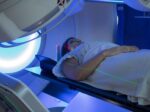Lung cancer is the most common cancer worldwide, ranking as the leading cancer in men and the second most common in women. According to the World Cancer Research Fund, there were 2,480,675 new cases of lung cancer diagnosed in 2022.
While persistent smoking remains the leading cause of lung cancer, several other risk factors contribute to its development. Passive smoking, exposure to asbestos, radon gas, and air pollution are notable environmental risks.
Personal factors such as age, family history, compromised immunity, previous radiotherapy to the chest (for example for breast cancer), and workplace exposure to harmful chemicals and substances (including silica, coal products, radon) can also elevate the likelihood of developing lung cancer.
Understanding these risk factors is crucial for prevention, early detection, and management strategies aimed at reducing its prevalence and improving outcomes.
At Proton International London, our highly experienced consultant radiation oncologists have an international reputation for providing the highest quality of care to patients with lung cancer.
What causes lung cancer?
Being aware of the variety of lung cancer risk factors that might increase your risk of developing the disease is important, but what’s also important is understanding what causes it and how it manifests in our bodies.
Due to any of the lung cancer risks highlighted above, cells in the lungs start to change in terms of their DNA makeup – the DNA is the genetic material in a cell and tells the cell what to do.
In a healthy cell, the DNA tells it to grow and multiply at a specific rate. However, part of this ‘instruction set’ also tells the cell to die once it has done its job. When a healthy cell’s DNA makeup changes, it starts giving out different instructions. The changes instruct the cell to multiply at a very rapid rate, higher than for normal cells, resulting in a proliferation of cells.
These cancer cells continue to live and thrive when healthy cells would die. With time, this leads to too many cells, in which case, those cancer cells form a mass – otherwise known as a tumour. This tumour can invade and destroy adjacent healthy tissue.
If not detected in time, the cancer cells can break away from their point of origin and spread to other parts of the body. A cancer that has spread around the body is referred to as a metastatic cancer.
Again, it’s worth noting that lung cancer can not only develop in people who smoke and inhale passive smoke but also in those who have never smoked or been exposed to any kind of second-hand smoke.
What is a risk factor?
A ‘lung cancer risk factor’ is anything that may increase your risk of developing lung cancer.
Just like other kinds of cancers, lung cancer has its unique risks, although having one or more of the risk factors described at the beginning of the article does not indefinitely mean that you will end up developing lung cancer.
What can increase your risk of developing lung cancer?
There can be multiple factors involved in lung cancer risk. Let’s discuss these in a bit more detail to help you understand how you may be at risk of developing lung cancer:
Family history & genetics
If anybody from your immediate family or a close relative has had lung cancer, then you are twice as likely to get it yourself.
Radiation therapy
Having had radiation therapy as part of a previous cancer treatment to the chest or breast can increase your risk of developing lung cancer.
HIV infection
HIV patients are at a higher risk of developing lung cancer.
Exposure to asbestos
Asbestos was banned in the UK in 1999, however, some construction workers in older buildings might still have been exposed to it. People involved in the repair or construction of large buildings or structures may be exposed to this substance as these constructions often contain asbestos.
If you’re a smoker, then your risk of lung cancer from asbestos exposure is even higher.
Exposure to tobacco smoke/cigarettes
It is well understood that people who don’t smoke are at a much lower risk of lung cancer.
However, inhaling other people’s tobacco smoke (passive or second-hand smoking) can increase your risk of lung cancer, which is why smoking has been banned in workplaces and enclosed public spaces in the UK.
Age and gender
One of the risk factors for lung cancer is age; older people are more likely to develop the disease, and indeed, 4 in 10 people in the UK who have lung cancer are 75 years and older. However, lung cancer can still develop in young people as well, although it is not common in those aged under 40.
Furthermore, men are at a higher risk of developing lung cancer than women, especially as they age.
Environmental risk factors
Aside from smoking, passive inhalation, and asbestos, there are other environmental lung cancer risk factors to consider:
- Silica, a substance used in specific construction and material industries, can increase your lung cancer risk, due to the development of a condition called silicosis.
- Diesel engine fumes can also increase your risk. People in a polluted city environment are at a higher risk of developing lung cancer, such as mechanics, professional drivers, or those who commute to work on foot or bicycle. Exposure to outdoor pollution is in fact responsible for 8 out of every 100 cases of lung cancer cases in the nation.
- Radon, a natural gas, is found in certain parts of the country, which passes from soil into the structure and foundation of buildings. Exposure to this gas is uncommon, but it is a recognised lung cancer risk factor, especially in people who smoke.
High beta-carotene doses
There is some research supporting the fact that high doses of beta-carotene supplements (20-30 mg a day) can increase lung cancer risk in smokers. Furthermore, you are also at a higher risk if you have smoked in the past.
Can you prevent or change the risk of lung cancer?
Yes, you can significantly reduce the major risk factors listed above and other risk factors.
Quitting smoking now
Many people choose to smoke despite knowing the risks it poses to their health, including the possibility of lung cancer. Smoking cigarettes is a major risk factor for lung cancer. By quitting smoking and not buying tobacco products, you can immediately lower your risk of lung cancer, no matter how long you’ve been smoking.
Stopping smoking can help to reduce your risk of lung cancer and can help you to live a longer, more fulfilling, and satisfying life. Quitting tobacco use is a lifestyle choice you can make today and it is something that will make you look and feel younger. If you need support to stop smoking, visit the NHS website where there are resources available to help support you to quit smoking.
Avoid passive smoking
Do your best to avoid second-hand smoke/passive smoking. That may mean not going to cafes or restaurants that have a “smoking” policy, making your home and car smoke-free, and generally avoiding people who smoke regularly or smoke in front of you. Their second-hand smoke is just as bad for you as it is for them.
Avoid radon exposure in your home
It can be a good idea to test your home for radon exposure and then, if it’s high, take the required steps to reduce it.
Avoid occupational exposure to toxic chemicals
If you work somewhere that may expose you to carcinogens such as toxic chemicals, follow all the Health and Safety guidelines.
Use the necessary protective gear or equipment if you are in an industry which requires handling of sensitive or toxic materials. Reducing occupational exposure as much as possible can often dramatically cut down your risk of lung cancer.
Maintaining an active lifestyle
Exercising and leading a generally active lifestyle is vital in reducing cancer incidence. By staying active, you improve your metabolism, immune system, blood circulation, energy levels, and particularly the production of red blood cells – all of which can help you remain healthy and help your body to prevent cancer from developing.
Maintaining a healthy diet
Maintaining a healthy diet can help to reduce lung cancer risk. A diet rich in fruits and vegetables will provide antioxidants which will keep the body’s cells healthy!
In addition, ensure that your diet is high in whole grains, seeds, and healthy (omega-3) fats, and low in trans and saturated fat. Foods with added sugars, high sodium and cholesterol should be avoided.
Drink plenty of water throughout the day and add in a cup of coffee or two for an extra dose of antioxidants.
Limiting exposure to radiation
Radiation directed at the chest used for medical imaging or treatment may increase your risk of lung cancer, so try to limit exposure as much as you can from CT scans, X-rays, radiation therapy, and PET CT scans.
Conclusion
Reducing your risk of lung cancer is sometimes as easy as not smoking and making the necessary diet and lifestyle changes. It’s also about reducing your exposure to environmental pollution and occupational toxic chemicals that can increase your risk of lung cancer, especially if you are currently smoking.
If you or anyone you know is at risk of lung cancer, or you have any symptoms that you are worried about, contact your GP to discuss the symptoms and to be checked to rule out the possibility of lung cancer.
Timely screening and early diagnosis and treatment can improve your chances or cure if you do have lung cancer.
Further reading:





